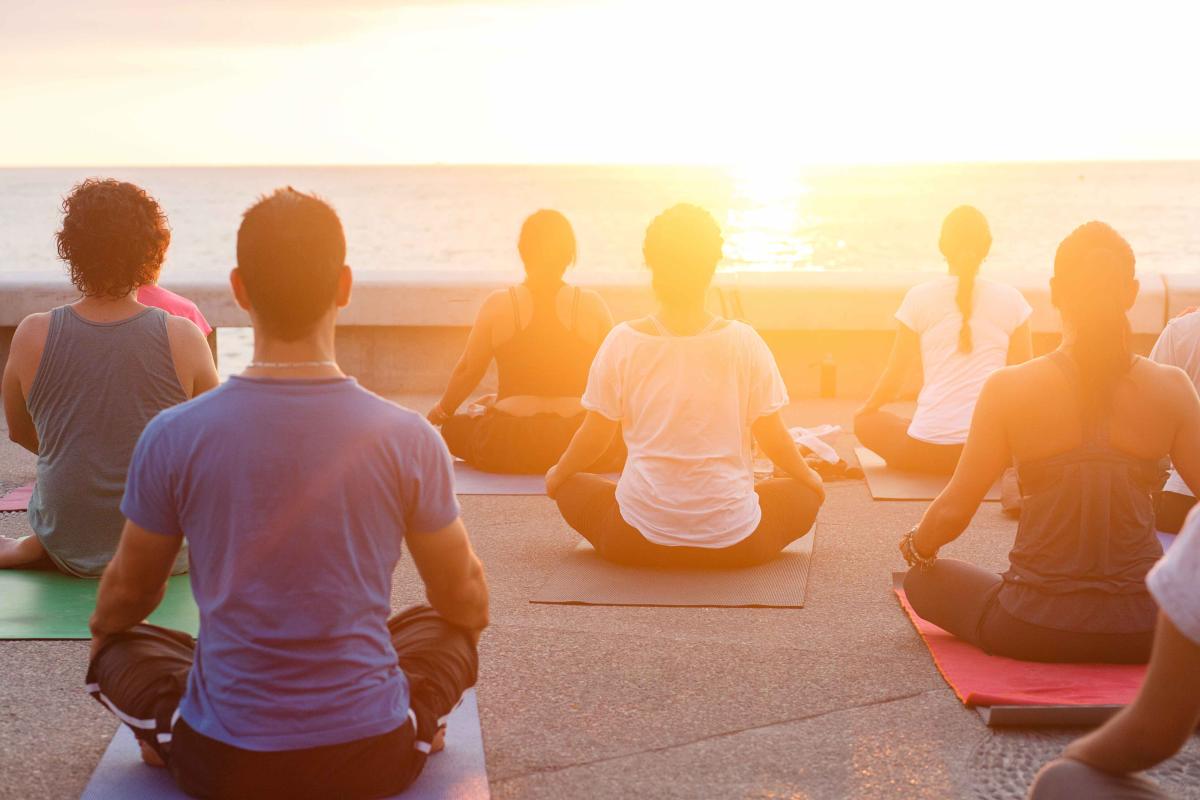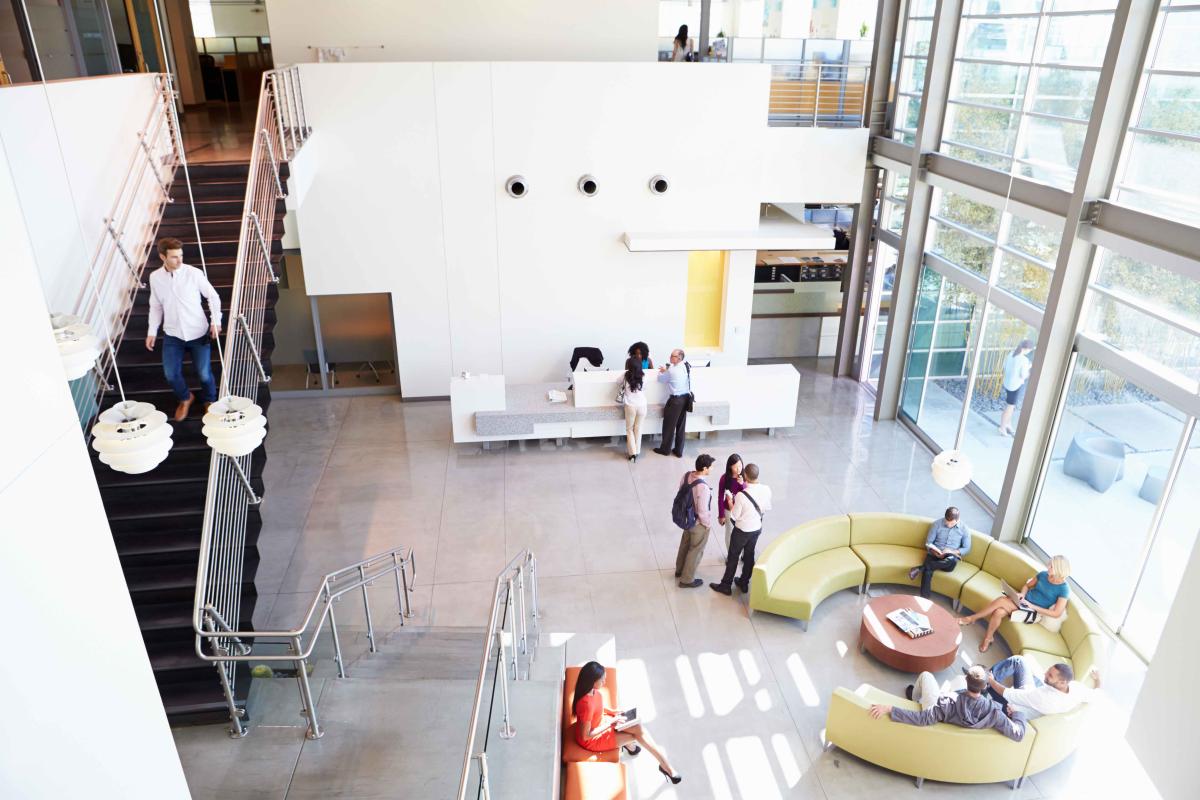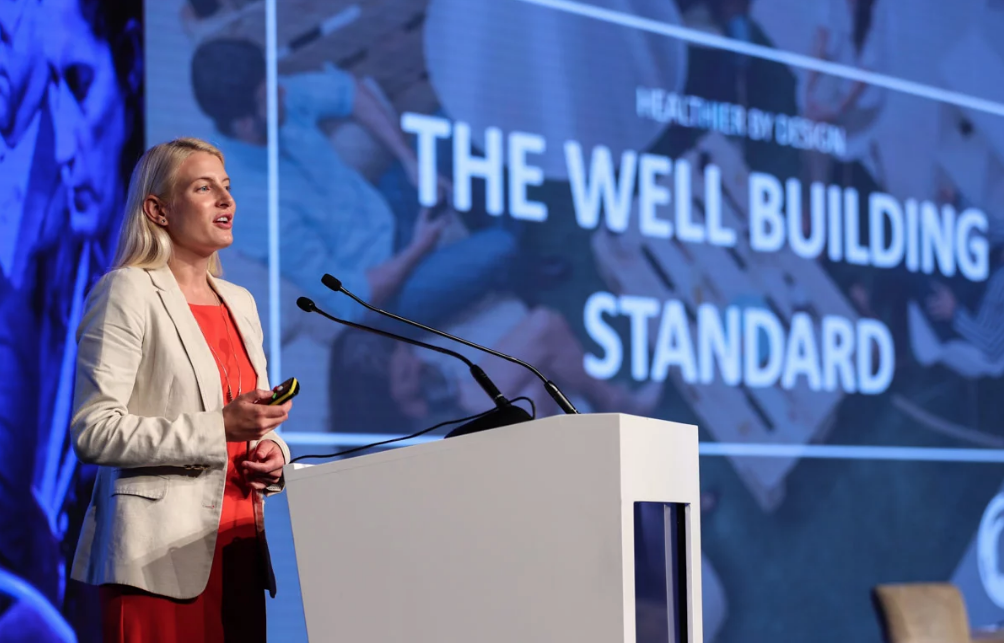WELL in the UAE: Trailblazing Towards a Happier, Healthier Future
by Kate Rube, Vice President, Technical Solutions
If you spend just a few days in Dubai, it’s clear how critical real estate has been to the city’s economic success and population: construction cranes scatter the sky, huge billboards advertise new homes from mega developers and model communities representing dozens of acres dominate the lobbies of many buildings. Yet real estate has also contributed to some of the biggest health and safety challenges that face Dubai and the broader Middle East today.
Large scale street networks have made it difficult or unpleasant to walk throughout parts of the city, contributing to a more inactive population and making road injuries the second leading cause of death in the UAE.[i] High rise buildings with valet service and no stairs in sight further discourage physical activity, which has helped lead to 66% of men and 60% of women living in the UAE becoming obese or overweight.[ii] And a recent survey of schools in UAE found that indoor air quality is suffering from high-levels of VOCs, chemicals that can be found in everything from paint to carpet to furniture, which off-gas and can contribute to headaches, nausea and fatigue.[iii]
However, as with most challenges, Dubai isn’t burying its head in the sand: it is aggressively setting goals and developing agendas to tackle these issues. The Dubai Health Strategy emphasizes the importance of prevention and healthy lifestyles to improving health outcomes, while the Dubai Plan 2021 puts people at its center. Its top goal is to help “individuals take care of their own wellbeing and their family members through proactive measures to manage their health.” Dubai’s Happiness Agenda is focused on fostering a more positive, engaged population, which is important for broader well-being.
Real Estate: Part of the Wellness Solution
Real estate can and needs to be a leader in fostering health and happiness in the region, as well. The WELL Building Standard is a vehicle to help accomplish these goals: it is the first building standard to focus exclusively on the health and wellness of the people in buildings, while the newly-launched WELL Community Standard sets protocols for designing healthy districts or neighborhoods.
WELL is grounded in a body of research that explores the connection between the buildings where we spend more than 90 percent of our time, and the health and wellness impacts on us as occupants. WELL Certified™ spaces can help create a built environment that improves the nutrition, fitness, mood, sleep patterns and performance of its occupants through performance requirements in seven concepts relevant to occupant health and well-being in the built environment: air, water, nourishment, light, fitness, comfort and mind. WELL Certified™ buildings and spaces need to pass performance testing in indoor air and water quality, lighting parameters and acoustics, providing occupants assurance about the health of their environment.
The WELL Community Standard builds on this framework, with more than 100 evidence-based strategies that designers and owners can incorporate into district-scale design, addressing issues that include healthy food access, outdoor thermal comfort, social space design and programming, and connection to local health services.
WELL Projects in UAE
While WELL just launched officially in October 2014, there are already 9 registered projects in UAE, mostly concentrated in Dubai. While some are private projects, the publicly identified projects includes:
-
Dubai Holding headquarters, a global investment conglomerate
-
XWorks Interiors office, an interiors fit-out company
-
du headquarters, a telecommunications firm
-
Moafaq Al Gaddah (MAG) Group’s multifamily residential development in Healthcare City; MAG is a multinational conglomerate based in Dubai
-
Zulekha Hospital in Sharjah
-
Alpin Limited (Masdar City) headquarters, a technical advisory firm for sustainable development
The projects are pursuing innovative ways of prioritizing health and wellness into their design, operations and policies. Dubai Holding’s (DH) new headquarters, for example, includes real-time air quality monitors, a walking track that runs throughout the office, dynamic Circadian lighting and design that prioritizes biophilia, with live plant walls, natural materials and images depicting nature.
Dubai Holding’s CEO, Edris Al Rafi led the development of DH’s new headquarters. Commenting on DH HQ’s alignment with WELL, he said: “For the past 10 years, Dubai Holding has invested heavily in the region’s first initiative to improve the well-being of employees, our award-winning Dubai Holding Corporate Wellness Programme. Building an innovative space that cultivates our staff’s overall happiness is a natural progression of our commitment to ensure our team’s long-term personal sustainability. At Dubai Holding, we understand that our staff’s well-being comprises a more cohesive, productive and efficient business entity, which contributes to creating a healthy and happy nation.”
Xworks Interiors is a Danish-owned and run design and build company focused on designing and delivering corporate interiors for the international clients. “With roots deeply set in the Scandinavia value set, it is obvious to for us to take a human centric approach to designing the workplace, both for our own employees and for our clients,” said Kaj Helstrand, Managing Director for XWorks. “We’re created a space that allows our team to thrive and feel inspired, but we are also demonstrating how design can serve as a game changer for the attraction and retention of talent, as we know how critical that is to a successful business. Essentially we want to serve as a WELL case study for the clients we serve.”
“Over the years, we have cultivated a powerful culture of well-being – one that staunchly values employee safety and wellness, work-life balance, and engagement,” said Abdulhadi Alalyak, Senior Vice President of Corporate Services, du. “The WELL Building Standard echoes our many initiatives and programmes such as our recent UL Certification for Good Indoor Air Quality, as well as our indoor facilities, like the gym, swimming pool and clinic, in addition to wellness initiatives that encourage employee health and well-being. Our focus in the future is to strengthen our well-being initiatives which are benchmarked against internationally recognised standards such as WELL.”
“Enhancing the quality of life and happiness of people is at the heart of any successful real estate conglomerate. We are very proud of MAG Creek because it fulfills the promise we made to improve people’s lives. It will be the first holistic wellness-focused resort to launch in the Middle East. Thanks to the Well Building Standard, we aim to be the first to provide residents with homes that actively contribute to their health and well-being in Dubai,” said Talal M. Al Gaddah, CEO, MAG Property Development.
Zulekha Hospital is a LEED-EBOM Platinum certified building that includes an open staircase that runs throughout its 12 floors, with artistic signage that encourages its use over the elevators to help people burn calories and incorporate physical activity in their daily lives. The hospital also conducts regular testing of its indoor air quality, water quality, lighting and acoustics. Taher Shams, Managing Director, Zulekha Hospitals, said “Becoming the first healthcare organisation awarded Platinum LEED certificate in the Middle East is a testimony to our long-term commitment to being an environmentally conscious and responsible business. We’ll continue to focus on our patients’ safety and well-being by ensuring exceptional healthcare service quality while protecting our environment in a proactive manner.”
Alpin’s office in Masdar City is already LEED Gold certified and the team is focused on achieving WELL certification with a high focus on health and employee comfort. Over the past year, Alpin has been updating its HR practices in order to align with WELL and to better foster team member engagement and productivity. “When updating our HR handbook in 2016, we used WELL as one of our main guides,” said Hala Hassan, HR Lead for Alpin. The company’s commissioning team has also worked to enhance the quality of air and water supplied to the space, and is currently working with the master developer to upgrade on-site features such as organic, healthy food choices and fitness opportunities.
The Value of Healthier Buildings and Communities
Making health and wellness central to a company, and to its real estate development, makes economic sense. By placing people at the heart of design, construction, operations and development decisions, companies have the ability to add value to real estate assets, generate savings in personnel costs, improve productivity, and better recruit and retain talent.
The physical workplace is one of the top three factors affecting performance and job satisfaction.[iv] In a recent survey, 42% of UAE employees described their offices as stressful and only 47% believed their company took an interest in their well-being, health and safety.[v] A separate survey of office workers in the Middle East found that improving environmental comfort was ranked as the number one change needed to improve their productivity.[vi] Addressing occupant health channels resources towards reducing the largest line item in the 30-year costs of a building – the personnel – offering a meaningful return on investment.
For a developer that is looking to lease office space or to sell residences, WELL can also provide a competitive edge. For example, in China, a registered WELL multifamily residential project has been ranked as China’s most anticipated development in 2016 by various real estate search engines and media outlets. According to the Sales Director, “At least 40% of buyers acknowledge the most desirable aspect of the Tianjiao project is the wellness benefit.”[vii]
In a survey last year of building owners, 73% said they believed that healthier buildings would positively affect leasing rates and 62% said they would have a positive impact on a building’s value.[viii]
Learn More about WELL
IWBI presented at this year’s Cityscape Global conference in Dubai. Cityscape Global is an annual conference and exhibition for the real estate industry in emerging markets and is one of the largest real estate events held globally. The event supports real estate growth worldwide to an international audience, highlighting iconic architecture, significant developments and investment opportunities. There are Cityscape events held annually in countries across the Middle East.
For a link to Kate’s Cityscape presentation, click here.
For more information about WELL in the Middle East or to discuss a potential project, contact Kate Rube.
[i] Institute for Health Metrics and Evaluation. UAE Profile. http://www.healthdata.org/united-arab-emirates
[ii] 1.Global Burden of Disease Study 2013, The University of Washington’s Institute for Health Metrics and Evaluation.
[iii] Evaluation of indoor environmental quality conditions in elementary schools ׳classrooms in the United Arab Emirates. Fadeyi, Moshood Olawale, et al., et al. 2014, Frontiers of Architectural Research, pp. 166-177.
[iv] American Society of Interior Designers. Recruiting and retaining qualified employees by design. White paper. 1999
[v] Anderson, Robert. 42% of UAE employees find workplace stressful – report. Gulf Business. June 3 2015 http://gulfbusiness.com/42-uae-employees-find-workplace-stressful-report/
[vi] RICS. And MECO. Office Environments and Productivity in the Middle East, 2016. http://www.rics.org/us/knowledge/research/insights/office-environments-and-productivity-in-the-middle-east/
[vii] Delos Project Profile Tianjiao. https://www.slideshare.net/StephenBrown48/deloswellprojectprofiletianjiao110416englishfinal
[viii] The Drive Toward Healthy Buildings 2016: Tactical Intelligence to Transform Building Design & Construction. Dodge Data & Analytics. 2016





